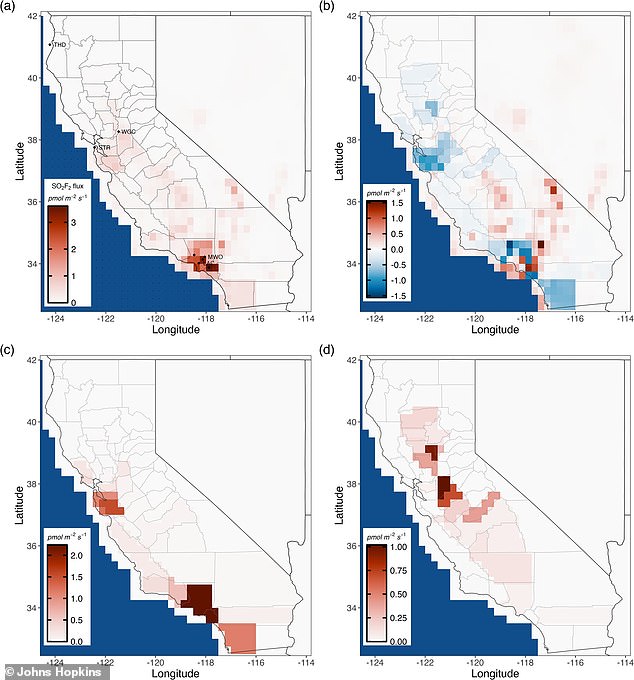Environmentally friendly California is America’s BIGGEST polluter – when it comes to the little-known greenhouse gas that has ‘gone under the radar’
- California is responsible for 12 percent of a little-known greenhouse gas
- The gas comes from a pesticide used to combat the state’s termite problem
- READ MORE: Californians say state is moving too fast on renewable energy
California leads the U.S. as the top emitter of a little-known greenhouse gas, despite the state pursuing several climate change initiatives.
Scientists at Johns Hopkins University have identified high levels of sulfide fluoride, a common pesticide for termites and ants, which is accumulating in the atmosphere and contributing to global warming.
The team analyzed more than 15,000 air samples collected between 2015 and 2019 by NOAA Global Monitoring Laboratory, finding up to 85 percent of U.S. greenhouse gas emissions came from The Golden State.
Data showed that the US is responsible for 17 percent of global sulfur fluoride emissions, but 12 percent comes from California.
Scientists at Johns Hopkins University have found high levels of sulfide fluoride, a common pesticide for termites and ants, found in just a few counties

Data showed the US is responsible for 17 percent of global sulfur fluoride emissions, but 12 percent comes from California
Lead author Dylan Gaeta said: ‘Without some form of intervention, sulfur fluoride will continue to build up in our atmosphere. For most greenhouse gases, California has made a very conscious choice in how it will reduce emissions.
“This one went under the radar.”
The analysis found that Los Angeles, Orange and San Diego counties are hotspots for the greenhouse gas; Los Angeles turned out to be the biggest emitter.
And since 2007, levels have steadily increased across California.

The analysis found that Los Angeles, Orange and San Diego counties are hotspots for the greenhouse gas; Los Angeles turned out to be the biggest emitter
“We can now show not only where, but also how and why this gas is emitted,” Gaeta said. “To reach net-zero emissions, we need a complete inventory of the greenhouse gases out there.”
The high levels of sulfide fluoride may be due to the state battling species that plague most of Southern California.
The most common, subterranean termites, live underground and build mud tubes to travel in the shade.
These pests also feed on wood and other cellulosic materials and can cause significant damage to homes and other structures.
“Notably, fumigation with sulfur fluoride provides no residual protection against future infestations, prompting repeated treatments of structures located in areas with ubiquitous termites,” said the study published in Nature.
Alternatives to pesticide use would include replacing wood, hot and cold water treatments, or microwave irradiation, but researchers noted that these “methods generally do not ensure the eradication of termites throughout the structure.”
The team searched California data on pesticide use and found that about 85 percent of sulfur fluoride emissions come from structural fumigation.
This involves enclosing an infested structure with an airtight tent, pumping gas into the tent to eradicate the pests, and then venting the gas directly into the atmosphere.
The remaining 15 percent was attributed to fumigation of agricultural products and raw materials.
When this greenhouse gas is released into the air, it will remain in the atmosphere for more than forty years.
‘The average concentrations of sulfuryl fluoride in the atmosphere are low; However, humans have been emitting the man-made gas for decades faster than it can break down naturally,” the team said.
